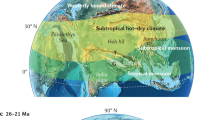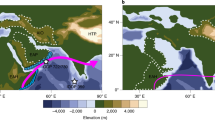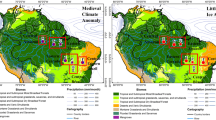Abstract
The climates of Asia are affected significantly by the extent and height of the Himalayan mountains and the Tibetan plateau1,2,3,4. Uplift of this region began about 50 Myr ago, and further significant increases in altitude of the Tibetan plateau are thought to have occurred about 10–8 Myr ago4,5, or more recently. However, the climatic consequences of this uplift remain unclear. Here we use records of aeolian sediments from China6,7 and marine sediments from the Indian8,9,10 and North Pacific oceans11 to identify three stages of evolution of Asian climates: first, enhanced aridity in the Asian interior and onset of the Indian and east Asian monsoons, about 9–8 Myr ago; next, continued intensification of the east Asian summer and winter monsoons, together with increased dust transport to the North Pacific Ocean11, about 3.6–2.6 Myr ago; and last, increased variability and possible weakening of the Indian and east Asian summer monsoons and continued strengthening of the east Asian winter monsoon since about 2.6 Myr ago. The results of a numerical climate-model experiment, using idealized stepwise increases of mountain–plateau elevation, support the argument that the stages in evolution of Asian monsoons are linked to phases of Himalaya–Tibetan plateau uplift and to Northern Hemisphere glaciation.
This is a preview of subscription content, access via your institution
Access options
Subscribe to this journal
Receive 51 print issues and online access
$199.00 per year
only $3.90 per issue
Buy this article
- Purchase on Springer Link
- Instant access to full article PDF
Prices may be subject to local taxes which are calculated during checkout




Similar content being viewed by others
References
Kutzbach J. E., Prell, W. L. & Ruddiman W. F. Sensitivity of Eurasian climate to surface uplift of the Tibetan Plateau. J. Geol. 101, 177–190 (1993).
Kutzbach J. E., Ruddiman, W. F. & Prell, W. L. in Tectonic Uplift and Climate Change (ed. Ruddiman, W. F.)) 149–170 (Plenum, New York, 1997).
Broccoli, A. J. & Manabe, S. The effects of orography on midlatitute Northern Hemisphere dry climates. J. Clim. 5, 1181–1201 (1992).
Molnar, P., England, P. & Martiod, J. Mantle dynamics, uplift of the Tibetan Plateau and the Indian monsoon development. Rev. Geophys. 34, 357–396 (1993).
Harrison, T. M., Copeland, P., Kidd, W. S. F. & Yin, A. Raising Tibet. Science 255, 1663–1670 (1992).
Sun, D. H., Liu, T. S., Chen, M. Y. & Shaw, J. Magnetostratigraphy and paleoclimate of Red Clay sequences from the Chinese Loess Plateau. Sci. China D. 40, 337–343 (1997).
Sun, D. H., An, Z. S., Shaw, J., Bloemendal, J. & Sun, Y. B. Magnetostratigraphy and palaeoclimatic significance of Late Tertiary aeolian sequences in the Chinese Loess Plateau. Geophys. J. Int. 134, 207–212 (1998).
Prell, W. L., Murray, D. W., Clemens, S. C. & Anderson, D. M. in Synthesis of Results from Scientific Drilling in the Indian Ocean (eds Duncan, R. A. et al.) 447–469 (Geophysical Monograph Series 70, American Geophysical Union, Washington DC, 1992).
Prell, W. L. & Kutzbach, J. E. in Tectonic Uplift and Climate Change (ed. Ruddiman, W. F.) 172–203 (Plenum, New York, 1997).
Kroon, D., Steens, T. N. F. & Troelstra, S. R. Onset of monsoonal related upwelling in the western Arabian Sea. Proc. ODP Sci. Res. 117, 257–263 (1991).
Rea, D. K., Snoeck, H. & Joseph, L. H. Late Cenozoic eolian deposition in the North Pacific: Asian drying, Tibetan uplift, and cooling of the Northern Hemisphere. Paleoceanography 13, 215–224 (1998).
Quade, J., Cerling, T. E. & Bowman, J. R. Development of Asian monsoon revealed by marked ecological shift in the latest Miocene of northern Pakistan. Nature 342, 163–166 (1989).
Cerling, T. E. et al. Global vegetation change through the Miocene/Pliocene boundary. Nature 389, 153–158 (1997).
Ma, Y. Z., Li, J. J. & Fang, X. M. Pollen assemblage in 30.6-5.0 Ma redbeds of Linxia region and climate evolution. Chinese Sci. Bull. 43, 301–304 (1998).
Porter, S. C. & An, Z. S. Correlation between climate events in the North Atlantic and China during the last glaciation. Nature 375, 305–308 (1995).
Kukla, G. & An, Z. S. Loess stratigraphy in central China. Paleogeogr. Paleoclimatol. Paleoecol. 72, 203–225 (1989).
An, Z. S. et al. Eolian evidence from the Chinese Loess Plateau: the onset of the late Cenozoic Great Glaciation in the Northern Hemisphere and Qinghai-Xizang Plateau uplift forcing. Sci. China D 42, 258–271 (1999).
Maher, B. A. Characterization of soils by mineral magnetic measurements. Phys. Earth Planet. Inter. 42, 76–92 (1986).
Chen, J., An, Z. S. & Head, J. Variation of Rb/Sr ratios in the loess-paleosol sequences of central China during the last 130,000 years and their implications for monsoon paleoclimatology. Quat. Res. 51, 215–219 (1999).
Shackleton, N. J., Hall, M. A. & Pate, D. Pliocene stable isotope stratigraphy of site 846. Proc. ODP Sci. Res. 138, 337–355 (1995).
Prell, W. L. & Kutzbach, J. E. Sensitivity of the Indian monsoon to forcing parameters and implications for its evolution. Nature 360, 647–652 (1992).
Zheng, H., Powell, C., An, Z., Zhou, J. & Dong, G. Pliocene uplift of the northern Tibetan Plateau. Geology 28, 715–718 (2000).
Li, J. J. et al. Late Cenozoic magnetostratigraphy (11-0 Ma) of the Dongshanding and Wangjiashan section in the Longzhong Basin, western China. Geol. Mijnbouw 76, 121–134 (1997).
Metivier, F., Gaudemer, Y., Tapponnier, P. & Meyer, B. Northeastward growth of the Tibet plateau deduced from balanced reconstruction of two depositional areas: the Qaidam and Hexi Corridor basins, China. Tectonics 17, 823–842 (1998).
Burchfiel, B. C. et al. Geology of the Haiyuan fault zone, Ningxia-Hui Autonomous region, China, and its relation to the evolution of the northeastern margin of the Tibetan Plateau. Tectonics 10, 1091–1110 (1991).
Royden, L. H. et al. Surface deformation and lower crustal flow in Eastern Tibet. Science 276, 788–790 (1997).
England, P. & Houseman, G. Finite strain calculations of continental deformation. Comparison with India-Asia collision. J. Geophys. Res. 91, 3664–3676 (1986).
Clemens, S., Murray, D. W. & Prell, W. L. Nonstationary phase of the Plio-Pleistocene Asian monsoon. Science 274, 943–948 (1996).
Raymo, M. E., Ruddiman, W. F. & Froelich, P. N. Influence of late Cenozoic mountain building on ocean geochemical cycles. Geology 16, 649–653 (1988).
Haug, G. H. & Tiedemann, R. Effect of the formation of the Isthmus of Panama on Atlantic Ocean thermohaline circulation. Nature 393, 673–676 (1998).
Ramstein, G., Fluteau, F., Besse, J. & Joussaume, S. Effect of orogeny, plate motion and land–sea distribution on Eurasian climate change over the past 30 million years. Nature 386, 788–795 (1997).
Acknowledgements
The model simulations used climate models and computer resources provided by the National Center for Atmospheric Research in Boulder, Colorado. This work was supported by the Chinese Academy of Sciences, the Chinese Ministry of Science and Technology, and the Chinese National Science Foundation, and by grants to the University of Wisconsin and Brown University from the US National Science Foundation.
Author information
Authors and Affiliations
Corresponding author
Rights and permissions
About this article
Cite this article
Zhisheng, A., Kutzbach, J., Prell, W. et al. Evolution of Asian monsoons and phased uplift of the Himalaya–Tibetan plateau since Late Miocene times. Nature 411, 62–66 (2001). https://doi.org/10.1038/35075035
Received:
Accepted:
Issue Date:
DOI: https://doi.org/10.1038/35075035
This article is cited by
-
Ensemble species distribution modeling and multilocus phylogeography provide insight into the spatial genetic patterns and distribution dynamics of a keystone forest species, Quercus glauca
BMC Plant Biology (2024)
-
A global dataset on species occurrences and functional traits of Schizothoracinae fish
Scientific Data (2024)
-
Proto-monsoon rainfall and greening in Central Asia due to extreme early Eocene warmth
Nature Geoscience (2024)
-
Early Paleogene precipitation patterns over East Asia: Was there a monsoon after all?
Palaeobiodiversity and Palaeoenvironments (2024)
-
Paleoclimatic application of spectral parameters to the eolian red clay of the Jianzha Basin, northeastern margin of the Tibetan Plateau
Science China Earth Sciences (2024)
Comments
By submitting a comment you agree to abide by our Terms and Community Guidelines. If you find something abusive or that does not comply with our terms or guidelines please flag it as inappropriate.



